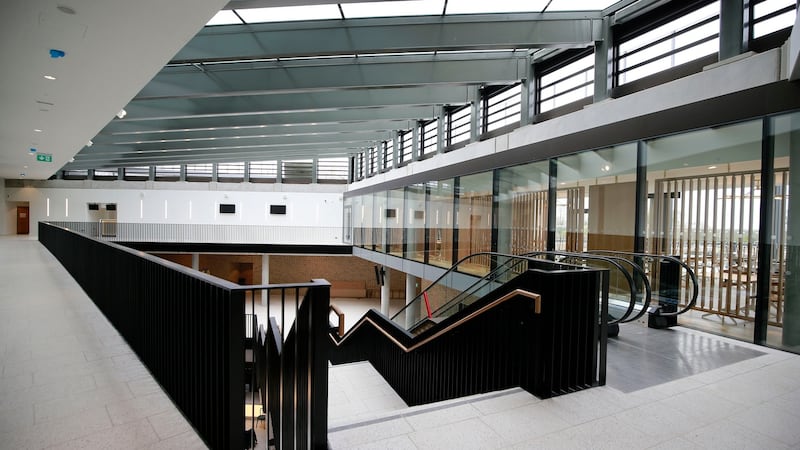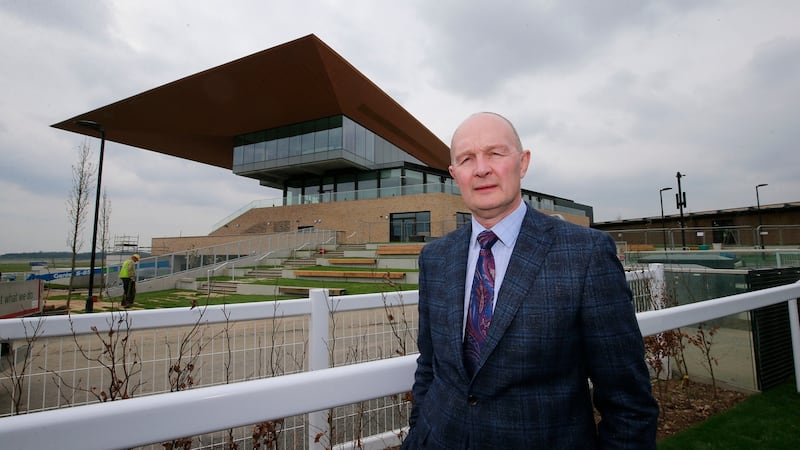Almost two decades after the Aga Khan announced a decrepit Curragh needed urgent resuscitation, construction work on Irish racing's spectacular new showpiece finally ended yesterday.
Originally dogged by planning problems, then sidelined due to the economic crash, at one stage the odds on the Curragh ever being revamped looked huge.
However, when racing at the historic racecourse resumes next month it will be in front of the sport’s biggest ever capital development project.
It is a project that has been mired in controversy and recrimination, accused of being a State-subsidised white elephant, the focus of rampant speculation as to financial overruns, not to mention it’s not even coming in on time.
However, even the most arch of sceptics is likely to have to concede the final result is breathtaking.
It has taken over two years for the sweeping new stand designed by Grimshaw Architects in London, and Limerick-based Newenham Mulligan, to take shape and banish the Curragh’s rustic old charms to memory.
The 10,500 square metre stand caters for up to 6,000 people inside its four levels while its surrounds can cope with over 10,000.
The stand’s sweeping 7,000 square metre roof is the most arresting feature of a facility containing 1,400 tonnes of structural steel, 8,900 tonnes of precast concrete, and boasting 4,300 square metres of glazing.
In total the Curragh will have a 30,000 crowd capacity, admittedly a figure traditionally threatened only on Derby day.
It’s why critics point to past attendances of just a few thousand on other classic days as evidence of the project being little more than an expensive vanity exercise for a wealthy elite that includes some of Ireland’s richest owners.
Just how expensive continues to be a source of intense speculation.
Curragh Ltd, the body made up of one third shares between private investors, the Irish Horseracing Regulatory Board which ran the Curragh until 2015, and the State through Horse Racing Ireland, still won’t reveal a final cost.
Originally projected to cost €65 million, that figure wasn’t long in increasing to €72 million. Officially that is still the price tag. Rumours have circulated for months though that delays and extra work on elements such as an expanded parade ring could drive the final tab towards €90 million.
Private investors
The IHRB’s one third share on the Curragh board acknowledges it provided the original asset. But the financial burden is carried by private investors and HRI. That begs the question as to who’ll pick up the cost of any overrun.
The original five private investors, John Magnier’s Coolmore Stud, Moyglare Stud, the Aga Khan, Sheikh Mohammed’s Godolphin operation and JP McManus, put in €5 million each.
Sheikh Hamdan's Derrinstown Stud subsequently joined them. Juddmonte Farms and David Power, co-founder of Paddy Power bookmakers, have also contributed to the project.
The Curragh chief executive Derek McGrath says the principle of any financial burden being equally divided between investors and the State still applies but couldn’t expand on details. He also indicated any final tot of the project’s costs may not be revealed until next month’s Guineas festival.
“We’re coming to the end of the project. We’re literally in final discussions and negotiations so it wouldn’t be in our interest to state what the figure is,” he said on Thursday.

“We have worked incredibly hard to get the right return. We have been very conscious of cost and return on investment, in terms of public money as well as private investment.
“It [any budget overrun] is a shareholder decision. But clearly HRI are a key part of it. But that really is a decision the shareholders will have to make. I say that because it is a pertinent conversation,” McGrath added.
If that seems as clear as mud then the new stand is testament to the breadth of architectural vision involved in its design and construction.
There are four levels with the bottom two open to the general public. The ‘Champions Hall’ on the first level is designed to accommodate up to 2,000 people. On non-race days provision has been made for it to be used to hold trade events such as car exhibitions.
The third level contains seven private suites accommodating 16 people each. The top floor of 13 exclusive boxes include those for investors and each is able to hold 30 people. The finishing touches were being put to them on Thursday.
“I like that there’s lots of light, lots of glass, and how the impression most people get is how compact it all is. Everything is quite close. Hopefully people find that it flows well,” said McGrath who pointed to the roof as a signature element.
“Hats off to the designers and the way it sits in the landscape here. You don’t get the sense of scale of the place when you look at it from the outside,” he added.
Central part
The design of the original parade ring hit the headlines last summer when regulatory officials concluded it was too small to hold every runner in races of 22 horses or more.
On the back of criticism of the decision to keep the Derby, and the second leg of ‘Irish Champions Weekend’ in situ despite temporary facilities and limited crowd capacity, the parade ring problem added to a sense of a somewhat beleaguered project.
The parade ring has been expanded to just over 182 square metres from 150 with a theoretical six metres for each horse. McGrath wouldn’t comment on any extra cost but said the work required took no more than eight weeks.
If the Curragh’s top races are by definition elitist, the decision to keep the Derby there during building work added to a sense of the ordinary racegoer being made to feel almost superfluous, something perhaps reflected in overall attendance figures despite the course being in the heart of Co Kildare.
Asked about his priorities for the new Curragh, McGrath said: “To be a central part of the community, that’s probably number one. To be regarded locally as a welcoming and good place to come and enjoy on race days and non-race days.
“Everyone on the board comes with their own hats on. But they want this to be a success for the public. The Aga Khan, in particular, is intent that people will enjoy it.

“It’s been a huge challenge and we’ve done all of it while racing. Our original plan was to be done by Christmas. But when you look around at the detail, to be finished this weekend, after an 18 month build, and to be over by three months, that’s not bad.
“We’ve not only physically transformed the Curragh but there’s another transformation going on and that is about who we are, how we work and how we present ourselves.
“This for me is when it gets interesting. There has to be a conversation about what we are trying to achieve and what this represents. What happens here represents far more than just a racecourse.
“You can see that in the anxiety of so many people that this is a success. I think it’s a conversation for the industry and the sport as to how we communicate this.
“I think the people who’ve invested see this as an investment in the sport. Yes they expect it to be a profitable business but what the profits will be used for will be considered going forward. But we know this place, if we get it right, will need more investment.”
Now that it’s built, the question is will they come?




















